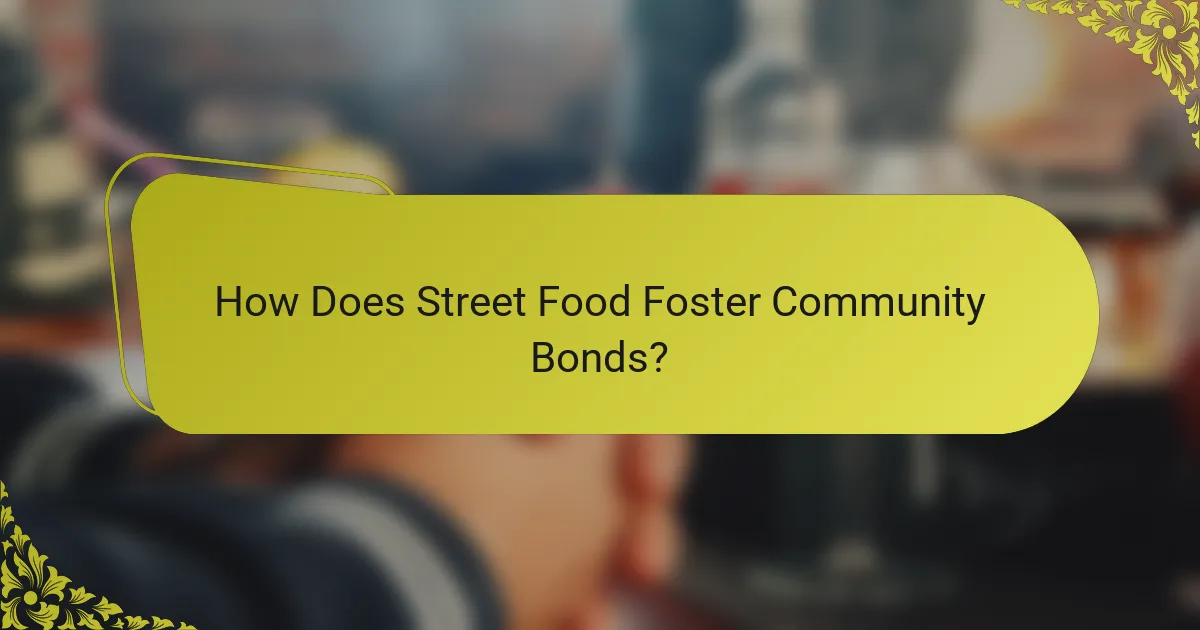Street food serves as a vibrant expression of local culture, offering unique flavors that reflect the ingredients and culinary traditions of various communities. Beyond satisfying hunger, it fosters social connections and cultural exchanges, creating shared experiences that strengthen community bonds. As street food continues to evolve, it remains an integral part of urban life, inviting both locals and visitors to partake in its rich tapestry of stories and flavors.

How Does Street Food Foster Community Bonds?
Street food fosters community bonds by creating shared experiences and local gatherings that bring people together. These interactions often lead to cultural exchanges, enriching the social fabric of neighborhoods and cities.
Shared experiences
Street food offers a unique opportunity for shared experiences among diverse groups. When people gather at food stalls or markets, they engage in conversations, share meals, and create memories together. This communal aspect helps strengthen relationships and build a sense of belonging.
For instance, food festivals featuring local street vendors often attract large crowds, allowing individuals to bond over their love for specific dishes. These events can create lasting connections among attendees, fostering a community spirit.
Local gatherings
Local gatherings centered around street food are essential for community interaction. Markets, food trucks, and pop-up stalls serve as informal meeting points where residents can socialize and enjoy culinary delights. These gatherings often become regular events, encouraging ongoing participation and camaraderie.
In many cities, weekly food markets not only provide access to affordable meals but also serve as venues for local musicians and artists, enhancing the community atmosphere. Such events can significantly boost local economies while reinforcing social ties.
Cultural exchange
Street food is a powerful medium for cultural exchange, allowing people to experience diverse culinary traditions. Vendors often share recipes and cooking techniques that reflect their heritage, inviting others to appreciate different cultures through food.
For example, a food truck offering fusion dishes can introduce traditional flavors from one culture to another, sparking conversations and curiosity. This exchange not only broadens culinary horizons but also fosters understanding and respect among different communities.

What Are Popular Street Foods Around the World?
Popular street foods vary widely across cultures, offering unique flavors and experiences. These foods often reflect local ingredients and culinary traditions, making them an integral part of community life.
Tacos in Mexico
Tacos are a quintessential Mexican street food, typically consisting of a corn or flour tortilla filled with various ingredients. Common fillings include grilled meats, beans, cheese, and fresh vegetables, often topped with salsa and lime.
Street vendors usually serve tacos in a casual setting, making them accessible and affordable. Prices can range from 10 to 50 Mexican Pesos (MXN) per taco, depending on the ingredients and location.
Pad Thai in Thailand
Pad Thai is a famous Thai street food dish made from stir-fried rice noodles, often combined with shrimp, chicken, or tofu, and flavored with tamarind, fish sauce, and lime. It’s typically garnished with peanuts and bean sprouts.
This dish is widely available from street vendors, with prices generally between 40 and 100 Thai Baht (THB). When enjoying Pad Thai, look for vendors with high turnover to ensure freshness.
Currywurst in Germany
Currywurst is a popular German street food consisting of steamed and fried sausage, sliced and served with a tangy curry ketchup. It’s often accompanied by fries or bread.
Street stalls selling Currywurst can be found in many German cities, with prices typically ranging from 3 to 7 Euros (EUR). This dish is a staple at festivals and markets, making it a must-try for visitors.

How Can You Start a Street Food Business?
Starting a street food business involves careful planning, from understanding the market to developing a unique menu. Key steps include conducting market research, securing necessary permits, and crafting an appealing food offering that resonates with your target audience.
Market research
Conducting thorough market research is essential for a successful street food venture. Identify your target customers, analyze competitors, and explore popular food trends in your area. Utilize surveys, social media insights, and local food festivals to gather valuable information.
Consider factors like location, pricing, and customer preferences. For example, if you notice a growing interest in vegan options, you might want to incorporate plant-based dishes into your menu to attract that demographic.
Permits and regulations
Securing the necessary permits and adhering to local regulations is crucial for operating legally. Requirements can vary significantly by city or country, so check with local health departments and business licensing offices. Common permits include food handling licenses and vendor permits.
Be aware of health and safety regulations, which often dictate food storage, preparation, and sanitation practices. Failing to comply can lead to fines or business closure, so ensure all paperwork is in order before launching.
Menu development
Menu development is a key aspect of your street food business that can set you apart from competitors. Focus on creating a concise menu that highlights your unique offerings while ensuring that items are easy to prepare and serve. Aim for a balance between variety and simplicity.
Consider seasonal ingredients and local flavors to enhance your menu’s appeal. For instance, if you’re in a coastal area, seafood dishes might resonate well with customers. Test your recipes with friends or at local events to gather feedback before finalizing your offerings.

What Are the Health and Safety Standards for Street Food?
Health and safety standards for street food focus on ensuring food is safe to consume, minimizing risks of foodborne illnesses. These standards encompass food handling practices, hygiene regulations, and local compliance, which vary by region but share common goals of protecting public health.
Food handling practices
Food handling practices are crucial for maintaining the safety of street food. Vendors should ensure that food is cooked to appropriate temperatures, typically above 75°C (167°F) for meats, to kill harmful bacteria. Additionally, using separate utensils for raw and cooked foods can prevent cross-contamination.
Regular handwashing with soap and water is essential, especially after handling raw ingredients. Vendors should also avoid touching food with bare hands and use gloves or utensils instead.
Hygiene regulations
Hygiene regulations dictate the cleanliness standards that street food vendors must adhere to. This includes maintaining clean cooking areas, proper waste disposal, and ensuring that food storage facilities are sanitary. Many regions require vendors to undergo food safety training to understand these regulations.
Regular inspections by local health authorities help enforce these hygiene standards. Vendors should be prepared for these inspections by keeping their stalls clean and ensuring that all food items are stored at safe temperatures, typically below 5°C (41°F) for perishables.
Local compliance
Local compliance refers to adherence to specific regulations set by municipal or regional authorities regarding street food. These regulations can vary widely, with some cities requiring permits, health inspections, and adherence to zoning laws. Vendors must familiarize themselves with local laws to operate legally.
In many areas, compliance also involves obtaining a food handler’s permit and passing health inspections. Vendors should stay updated on any changes in local regulations to avoid fines or shutdowns, ensuring their business remains operational and safe for consumers.

How Does Street Food Reflect Cultural Significance?
Street food serves as a vibrant expression of cultural identity, showcasing local flavors, traditions, and community bonds. It reflects the history and social dynamics of a region, often becoming a symbol of national pride and culinary heritage.
Historical roots
The historical roots of street food can be traced back to ancient civilizations where vendors sold food in public spaces. In many cultures, these practices evolved from the need for quick, affordable meals for workers and travelers, establishing a tradition that persists today.
For instance, in cities like Rome, street food was a staple for the working class, while in Asia, food stalls have been integral to community life for centuries. These historical practices have shaped modern street food scenes, influencing the types of dishes available and their preparation methods.
Regional variations
Street food varies significantly across regions, reflecting local ingredients, customs, and culinary techniques. In Mexico, for example, tacos and elotes are popular, while in Thailand, pad thai and som tam dominate the street food landscape.
These regional variations not only highlight the diversity of flavors but also showcase how geography and climate influence food choices. For instance, coastal areas may feature seafood dishes, while inland regions might focus on meats and grains.
Festivals and traditions
Street food plays a crucial role in festivals and cultural traditions, often serving as a centerpiece for communal gatherings. Events like the Night Market in Taiwan or the Food Festival in Melbourne celebrate local street food, drawing crowds to enjoy a variety of dishes.
During these festivals, street food vendors often showcase traditional recipes passed down through generations, reinforcing cultural heritage. Additionally, these events provide opportunities for communities to bond over shared culinary experiences, strengthening social ties.
